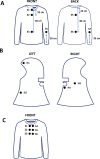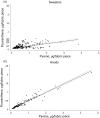Contamination of firefighters' merino wool and mixed fibre sweater and hood undergarments with polycyclic aromatic hydrocarbons
- PMID: 40583247
- PMCID: PMC12313446
- DOI: 10.1093/annweh/wxaf031
Contamination of firefighters' merino wool and mixed fibre sweater and hood undergarments with polycyclic aromatic hydrocarbons
Abstract
Background: Several authors have studied contamination of polycyclic aromatic hydrocarbons (PAHs) found on the outer gears of firefighters, but to our knowledge, none have investigated merino wool and mixed fibre undergarments used underneath the protective turnout gear. We therefore performed a comprehensive study regarding selected PAHs in pieces cut out from different areas of firefighter's sweaters and hood used in real fires and laundered after each use.
Method: Hoods (38) and sweaters (58) were donated by 3 fire departments and from these garments 558 pieces of fabric were cut out. Extracts of the fabric pieces were analysed by liquid chromatography with ultraviolet and fluorescence detection for 7 PAHs: anthracene, benzo[a]pyrene, chrysene, fluoranthene, naphthalene, phenanthrene, and pyrene. In addition, a small study was performed to examine the removal of PAHs from sweaters during laundry.
Results: Trace amounts of anthracene, benzo[a]pyrene, fluoranthene, and pyrene were detected both in merino wool and mixed fibre sweaters and hoods with highest concentrations for the hoods and lowest for the back of the sweaters. Highest concentration was found for the forehead position of the hoods. Significantly higher concentrations of PAHs were found in both hoods and sweaters containing the textile meta-aramid. Laundering reduced the amount of PAHs-in the sweaters but not completely.
Conclusion: Trace levels of benzo[a]pyrene and 3 other PAHs could be found in firefighters routine laundered undergarments. Cleaning reduced the PAH levels but not completely, and textiles with meta-aramid contained more PAHs than those without. Merino wool and mixed fibre undergarments are used in many countries and the results are valuable outside this study.
Keywords: PAH; benzo[a]pyrene; fire-department; garments; linear mixed tobit regression model; merino wool; meta-aramid; protective gear; turnout gear.
© The Author(s) 2025. Published by Oxford University Press on behalf of the British Occupational Hygiene Society.
Conflict of interest statement
The authors declare no conflicts of interest.
Figures



Similar articles
-
Addressing the need for individual-level exposure monitoring for firefighters using silicone samplers.J Expo Sci Environ Epidemiol. 2025 Apr;35(2):180-195. doi: 10.1038/s41370-024-00700-y. Epub 2024 Jul 20. J Expo Sci Environ Epidemiol. 2025. PMID: 39033252 Free PMC article.
-
Firefighter hood contamination: Efficiency of laundering to remove PAHs and FRs.J Occup Environ Hyg. 2019 Feb;16(2):129-140. doi: 10.1080/15459624.2018.1540877. Epub 2019 Feb 7. J Occup Environ Hyg. 2019. PMID: 30427284 Free PMC article.
-
Urinary Metabolites of Polycyclic Aromatic Hydrocarbons in Firefighters: A Systematic Review and Meta-Analysis.Int J Environ Res Public Health. 2022 Jul 11;19(14):8475. doi: 10.3390/ijerph19148475. Int J Environ Res Public Health. 2022. PMID: 35886320 Free PMC article.
-
Relationship between polycyclic aromatic hydrocarbons measured in dust collected inside cars and from ambient air.Environ Toxicol Chem. 2025 Jul 18:vgaf183. doi: 10.1093/etojnl/vgaf183. Online ahead of print. Environ Toxicol Chem. 2025. PMID: 40680171
-
Health Risks of Structural Firefighters from Exposure to Polycyclic Aromatic Hydrocarbons: A Systematic Review and Meta-Analysis.Int J Environ Res Public Health. 2021 Apr 15;18(8):4209. doi: 10.3390/ijerph18084209. Int J Environ Res Public Health. 2021. PMID: 33921138 Free PMC article.
References
-
- Aliano-Gonzalez MJ, Montalvo G, Garcia-Ruiz C, Ferreiro-Gonzalez M, Palma M.. 2022. Assessment of volatile compound transference through firefighter turnout gear. Int J Environ Res Public Health. 19:3663. https://doi.org/ 10.3390/ijerph19063663 - DOI - PMC - PubMed
-
- Asif MK, C.; Gilani, S.J.; Imam, M.T.; Alshehri, S.; Kahn, N.A.. 2022. Protective textiles from natural resources. The Textile Institute Book Series. Woodhead Publishing, Elsevier Ltd., p. 611–647. https://doi.org/ 10.1016/b978-0-323-90477-3.00013-4> - DOI
-
- Banks APW, et al. 2021. Assessing decontamination and laundering processes for the removal of polycyclic aromatic hydrocarbons and flame retardants from firefighting uniforms. Environ Res. 194:110616. https://doi.org/ 10.1016/j.envres.2020.110616. - DOI - PubMed
-
- Bormann JL, Maibach HI.. 2020. Effects of anatomical location on in vivo percutaneous penetration in man. Cutan Ocul Toxicol. 39:213–222. https://doi.org/ 10.1080/15569527.2020.1787434. - DOI - PubMed
-
- Easter E, Lander D, Huston T.. 2016. Risk assessment of soils identified on firefighter turnout gear. J Occup Environ Hyg. 13:647–657. https://doi.org/ 10.1080/15459624.2016.1165823. - DOI - PubMed
MeSH terms
Substances
Grants and funding
LinkOut - more resources
Full Text Sources
Medical
